 |
DEPARTMENT
RESULTS |
|
|
|
Goal:
Increase the speed, accuracy, convenience and ease of tax filing and paying |
|
Why
is this goal important? 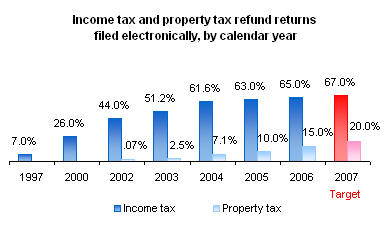
Because
the revenue system relies on voluntary compliance, it must have the support
and cooperation of its citizens. The department’s role is to make it easy
and convenient for taxpayers to fulfill their filing and paying obligations.
The department also has an obligation to manage its operations as
efficiently as possible, and to make prudent investments in appropriate
technology.
Electronic filing and paying helps us
accomplish both goals. For taxpayers, e-filing is fast, secure, and
accurate; for the department and the state, e-filed returns and payments are
less costly to process than paper returns.
|
|
How will this goal be accomplished?
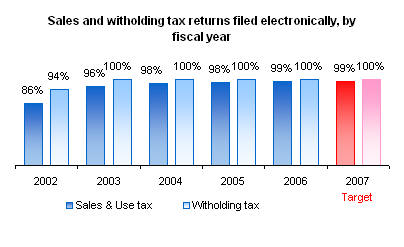
Our
transition from paper began in 1994, with mandatory paperless filing for the
newly enacted MinnesotaCare tax. Since then, we have worked to shift other
business taxes to e-filing and paying. In 2001, e-filing reached another
milestone when the sales and withholding tax systems eliminated paper
filing; businesses now file these returns via the Internet, or by telephone.
Individual income tax filers are also
leaving paper behind. The department works to encourage e-filing through
partnerships and information campaigns directed at individuals and tax
preparers. In addition, we have worked with the IRS to increase the number
of e-filings.
|
|
What is
Revenue's progress to date?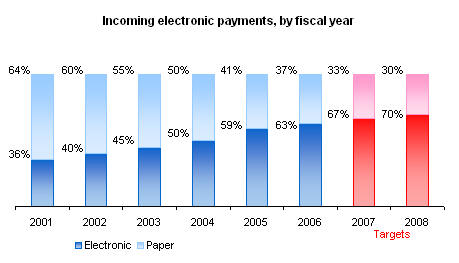
●
The number of returns filed electronically has steadily increased since
2001. This transition from paper to electronic filing is improving
the speed, accuracy and convenience of tax filing for citizens. The result
is that taxpayers who file electronically can receive their tax refunds in
just a few days and about 98 percent of all income tax filings are error
free.
In 2006, 65 percent of individual income tax returns and 15 percent of
property tax refund returns were filed electronically. The department
exceeded its 2006 electronic filing goals- 60 percent for individual income tax
and 10 percent for property tax refund filers.
In FY 2006, the department exceeded its electronic return goals for business taxes-98
percent for sales and use tax returns and 99 percent
for withholding returns.
● The number of payments made electronically is an indicator of improved
efficiency of tax payment processing. Electronic payments are less costly to
process. In 2006, 63 percent of payments for all tax types were made
electronically. In terms of revenue, those payments accounted for 85 percent
of dollars received.
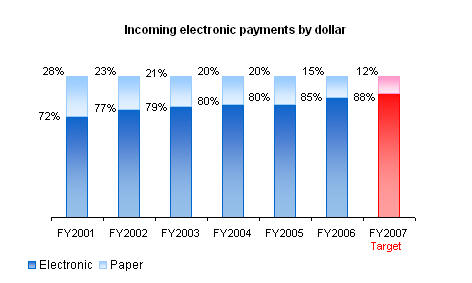
● The department surveys citizens every two years to determine their
satisfaction with the filing process. Their responses tell us whether we are
achieving our goal of making it easy and convenient for taxpayers to fulfill
their filing and paying obligations. According to the 2005 survey results,
93 percent of
respondents said they were satisfied with the time it took to get a refund. Our goal is to increase that
number to 98 percent by the time of the 2007 survey. Usefulness of the
information received from the department was given a satisfaction rating of 75 percent in 2005. Strategies to improve these
survey results and ultimately customer satisfaction with filing and paying,
are being developed. 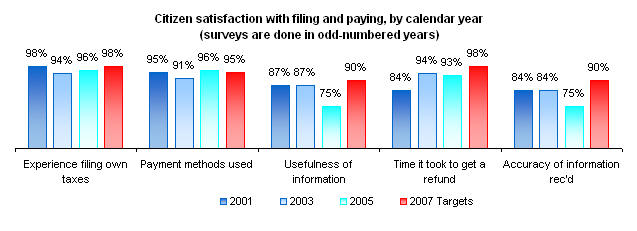 |
|
Learn more at:
 http://www.taxes.state.mn.us/taxes/legal_policy/other_supporting_content/
http://www.taxes.state.mn.us/taxes/legal_policy/other_supporting_content/
leg_pol_other_publications.shtml |
|
|
|
Goal:
Increase e-services for citizens |
|
Why
is this goal important?
In the last decade, the Internet has become a major channel for information
and commerce. Meeting the needs of citizens and businesses for electronic services is
essential to achieving voluntary compliance with the tax system.
How will this goal be accomplished?
We have created web and phone self-service systems to enable
people to get the information they need to file and pay their taxes, check
on their refunds, make payments, update their information, and set up
payment plans for delinquent taxes.
|
|
|
|
|
|
What is
Revenue's progress to date?
●
Use of the department’s web services has
grown dramatically. For example, in 2006, there were over 375,000 visits to
the “Where’s My Refund” web application- 23 percent increase from 2005. This
increase reflects taxpayer acceptance of and appreciation for the
convenience of online services. With the growing reliance on our web
s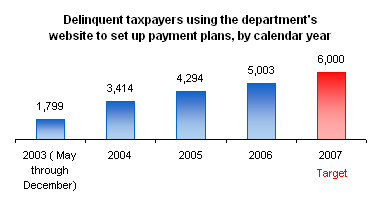 ervices, fewer calls are coming in to the department's refund information phone line. In 2006, this service received 312,000 calls-a 15 percent
decrease from 2005. ervices, fewer calls are coming in to the department's refund information phone line. In 2006, this service received 312,000 calls-a 15 percent
decrease from 2005.
●
In May 2003, we launched a new online service to make it easier for
people with delinquencies to pay their tax debts. Today, 27 percent of the
pay plans created were made on the web; our goal for 2007 is to increase
this percentage to 30 percent.
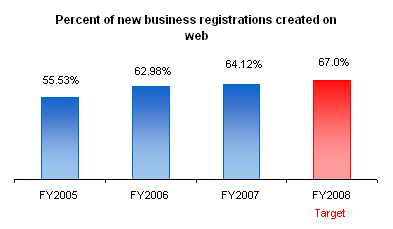
●
The department also offers e-services for
businesses. In FY2007, 64 percent of new business registrations were created
on the web. In 2007, the department launched a new service for employers
that enables them to submit employee W-2 forms electronically.
|
|
Goal:
Ensure that the tax system keeps pace with changes in the economy,
demographics and technology |
|
Why is this goal
important?
Minnesota
is home to a growing number of limited English speakers;
between 2000 and 2025, Minnesota’s Asian-Pacific population is
expected to double, and its Hispanic
population will be two and a half times what it is today. Keeping pace with
demographic changes is essential in order to ensure that all citizens have
access to the services and information they need to meet their tax obligations.
The economy continues to shift from
industrial production to services; and traditional bricks-and-mortar
businesses face increasing competition from the electronic marketplace. To
ensure fairness, stability, and adequate revenues, the tax system must accommodate these
changes.
Further, we must keep pace with changes
in technology, both to protect our information and processes, and to improve
the delivery of our services. We are moving our critical database and
network components to newer technologies that will give us the flexibility
to meet demands for services and will ensure the integrity of our
information and processes.
|
|
How will this goal be accomplished?
To reduce the language barriers that keep new citizens from complying with
the tax system, we have hired bilingual employees to provide income tax
education services to the Hispanic, Asian-Pacific, and East African communities.
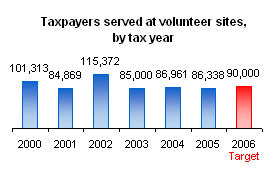 We provide
tax help and work to establish self-sustaining volunteer groups to provide
consistent, year-to-year help in filing returns. We also provide key tax
information in languages other than English on our website. We provide
tax help and work to establish self-sustaining volunteer groups to provide
consistent, year-to-year help in filing returns. We also provide key tax
information in languages other than English on our website.
Our strategies call for greater
integration of information, improved citizen access to services, and
self-service capabilities for all users. We are working to reduce the
department’s reliance on obsolete technology and to diminish the risk of
system failures by replacing aged computer systems. Besides ensuring the
stability of our applications and the integrity of our information, improved
tools will enable us to provide better information to citizens and policy
makers.
|
|
What is
Revenue's progress to date?
● Progress toward
helping limited-English-speaking Minnesotans meet their tax obligations can
be measured by the number of people served at volunteer tax preparation
sites and the number of state tax returns completed. These
department-sponsored sites serve non-English-speaking, low income, and
elderly Minnesotans. By the end of 2006, the number of state tax returns
completed for the 2005 tax year was 73,705, which represents a 2.6 percent
increase over the number of returns completed for the previous tax year
(71,856).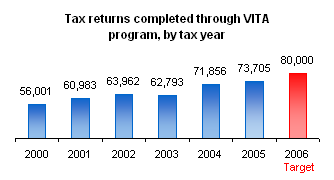
● Since 2004,
we have offered a bilingual English-Spanish version of the
individual income tax and property tax refund instructions on our website.
Other Spanish-language website offerings include income tax, sales tax, and property
tax fact sheets. Our website also provides information on the Working Family
Credit and the Taxpayer Rights program in eight languages other than
English. In 2006, the department expanded its outreach by offering a
Spanish-language sales tax workshop for new businesses.
●
Increased reliance on new technology and the increase in the number of
electronic and self-service transactions have helped reduce the overall
administrative cost per transaction. As an example, in FY 2006, it cost
$1.15 to process each transaction, which is 2 cents less per transaction
than in FY 2005. ●
In the last two years, we have advanced our modernization goals by replacing
our aging network infrastructure, including updating our desktop and network
operating systems; expanding the IP telephone system to regional offices;
and installing a storage area network ●
We also began the process of modernizing our
property tax system and implemented a new system to accommodate the sales
tax returns and payments that flow from the national Streamline Sales Tax
Project system. ●
Finally, we have converted paper partnership income tax returns to images,
thereby reducing storage space needed for forms and giving employees
immediate access to information, and scanned all correspondence from
delinquent taxpayers, which has created a virtually paperless work
environment in the agency's Collection Division.
|
|
Goal: Improve compliance
with the tax system |
|
Why
is this goal important?
If
Minnesota’s revenue system is to work well, fairness is essential; a fair
system means that everyone pays the right amount of tax, no more, no less.
However, a significant number of individuals and businesses with Minnesota
tax liabilities do not pay all they owe, or do not file or pay at all.
Noncompliance carries a substantial price tag: the Minnesota tax gap—the
estimated difference between what is owed the state and what is actually paid—is
$1.3 billion. To create a fairer tax system for all, these
under-reporters and nonfilers must be brought into compliance.
|
|
|
How will this goal be accomplished?
We
are focusing audit and enforcement activities on those who are furthest from
compliance. Besides the revenues they produce, these activities carry an
additional benefit, in that the visibility they generate also improves
voluntary compliance.
In addition to audit and enforcement, we
have formed partnerships with other states to simplify sales tax collection
on out-of-state purchases, are working to identify ways to reduce the
complexity of the sales tax laws, and are providing education opportunities
for businesses. These efforts will help ensure that everyone is paying the
right amount. |
|
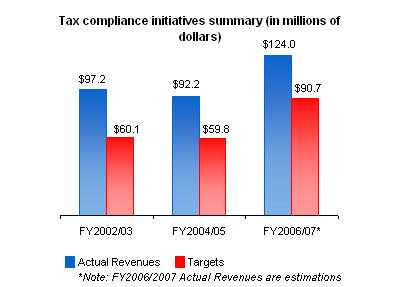 What is
Revenue's progress to date? What is
Revenue's progress to date?
●
One measure of progress toward improving compliance is to track how much in
increased revenues we are able to collect through stepped-up auditing and
enforcement. In the 2004-2005 biennium, we collected approximately $92.2
million through these compliance initiatives—$30 million more than had been
projected. The department received additional funds for FY 2006-2007; based
on current collections, these initiatives are projected to bring in $124
million by the end of the biennium. This amount would be $33 million more
than had been projected.
|
| |
|
Learn more at:
 http://www.taxes.state.mn.us/taxes/legal_policy/other_supporting_content/tax_gap_study.pdf
http://www.taxes.state.mn.us/taxes/legal_policy/other_supporting_content/tax_gap_study.pdf
 http://www.taxes.state.mn.us/taxes/legal_policy/research_reports/content/
tax_gap_study.shtml
http://www.taxes.state.mn.us/taxes/legal_policy/research_reports/content/
tax_gap_study.shtml |
|
Last update on
08/08/2007
|
|








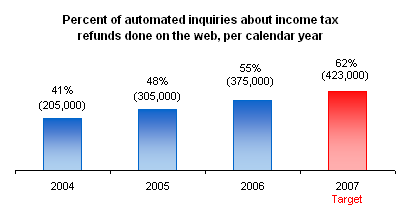

 ervices, fewer calls are coming in to the department's refund information phone line. In 2006, this service received 312,000 calls-a 15 percent
decrease from 2005.
ervices, fewer calls are coming in to the department's refund information phone line. In 2006, this service received 312,000 calls-a 15 percent
decrease from 2005.


